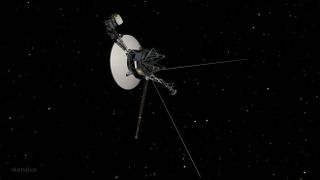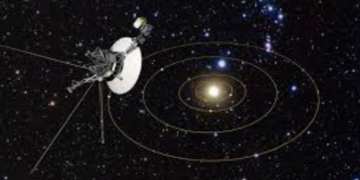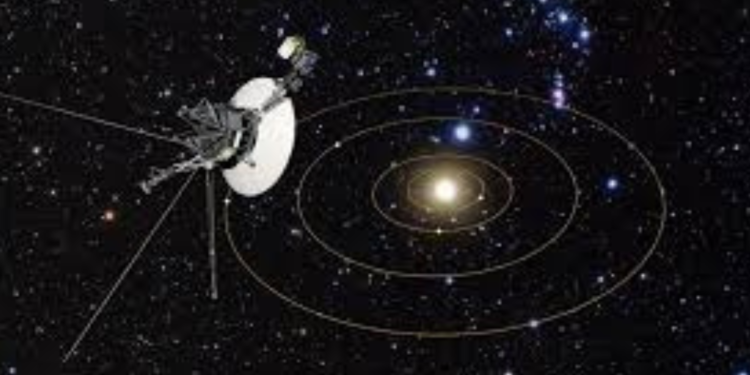Voyager 1, humanity’s farthest flung emissary, has been singing a discordant tune for months. Instead of the symphony of scientific data it once relayed from the fringes of our solar system, mission control received a cacophony of nonsensical signals. Thankfully, NASA’s engineers have finally identified the conductor causing this cosmic static – a corrupted chip in the spacecraft’s memory.
A Pioneering Probe with a Glitch

Launched in 1977, Voyager 1 embarked on a daring adventure to explore the outer reaches of our solar system. In 2012, it achieved a historic feat, becoming the first human-made object to enter interstellar space, the vast expanse beyond the Sun’s protective bubble. But in May 2022, mission control noticed a troubling change. The data flowing from Voyager 1, once a treasure trove of scientific insights, became a nonsensical jumble of ones and zeroes.
Diagnosing the Deep Space Hiccup
NASA’s engineers, determined to restore communication with their valiant probe, embarked on a mission of their own – a cosmic diagnosis. They honed in on the Flight Data System (FDS), the maestro responsible for orchestrating the data collected by Voyager 1’s instruments. It turned out the culprit was a single, faulty chip within the FDS. This chip, likely worn from decades of service or perhaps struck by an energetic particle from the harsh interstellar environment, was corrupting the data before it could be transmitted back to Earth.
A Memory Lapse in the Cosmos
The corrupted chip meant the FDS could no longer properly communicate with the Telemetry Modulation Unit (TMU), the component responsible for beaming the data back to Earth. Instead of a clear and concise message, the TMU was transmitting an endless loop of meaningless ones and zeroes. This was akin to a musician trying to play a beautiful melody with a broken instrument, the result being a disjointed and frustrating soundscape.
Healing the Voyager 1: A Data System Reboot
But NASA’s engineers aren’t giving up on their interstellar voyager. On March 1st, they sent a “poke” to the spacecraft, a carefully crafted command designed to nudge the FDS software and identify the corrupted section. This digital prod proved successful. Two days later, Voyager 1 responded with a complete readout of its memory, allowing engineers to compare it to a previous snapshot and pinpoint the corrupted bits.
The analysis revealed that only about 3% of the FDS memory was affected. With this knowledge, the team is now brainstorming ways for the FDS to bypass the corrupted section and resume normal operations. This would allow Voyager 1 to once again send valuable scientific data about the interstellar medium, continuing its mission as a celestial ambassador for humanity.
A Testament to Human Ingenuity: A Song Restored
Voyager 1’s glitch serves as a powerful reminder of the vast distances and harsh environments involved in deep space exploration. The challenges are immense, and malfunctions are inevitable. But it also highlights the remarkable ingenuity of NASA’s engineers. Their dedication and expertise are key to keeping this intrepid spacecraft operational, allowing it to continue its historic journey and transmit its celestial song back to Earth. The future of Voyager 1 remains bright, and with a little ingenuity, its interstellar symphony is sure to resume, offering us a glimpse into the wonders that lie beyond our solar system.
Beyond the Glitch: A Legacy of Exploration
The Voyager 1 mission is a testament to human curiosity and our desire to push the boundaries of knowledge. Launched during a golden age of space exploration, it has journeyed farther than any other human-made object, providing us with unprecedented insights into the outer reaches of our solar system and the mysterious realm of interstellar space. The data it has collected has revolutionized our understanding of the planets, moons, and other celestial bodies it has encountered. Even in its current state, with a partially compromised memory, Voyager 1 serves as a beacon of human achievement, a solitary outpost carrying our message and scientific aspirations into the vast cosmic ocean.
The glitch may have temporarily silenced Voyager 1’s scientific chorus, but it has not dimmed the significance of its mission. The efforts to restore its functionality speak volumes about human perseverance and our commitment to unraveling the secrets of the cosmos. As NASA’s engineers grapple with the corrupted memory, the world awaits with anticipation, eager to hear the celestial song of Voyager 1 resume, a testament to both the wonder of scientific exploration and the boundless human spirit.



















